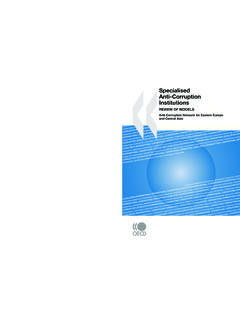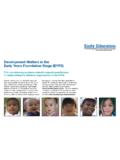Transcription of Literature Review: Impact of Technology Change …
1 Literature review : prepared by Ruth Grossman (September 2008) for Impact of Technology Change on Issue Areas Relevant to Connectivity in Remote and Indigenous Communities CCIRDT and NICSN. Literature review : Impact of Technology Change . on ISSUE AREAS RELEVANT to CONNECTIVITY. in REMOTE and INDIGENOUS COMMUNITIES. prepared by Ruth Grossman September 2008. for CCIRDT. (Centre for Community Informatics Research Development and Training). and NICSN. (Northern Indigenous Community Satellite Network). 1. Literature review : prepared by Ruth Grossman (September 2008) for Impact of Technology Change on Issue Areas Relevant to Connectivity in Remote and Indigenous Communities CCIRDT and NICSN. INTRODUCTION: The purpose of this review is to identify what is currently known and what is currently not known, as recorded in the published Literature , about issues relevant to broadband connectivity in remote and aboriginal communities.
2 While this preliminary research is primarily concerned with application to the Canadian experience, and specifically to projects and initiatives of NICSN, a broader usefulness to undertakings in the global arena is also anticipated. Accordingly, the review casts a deliberately wide net in the interest of bringing a comprehensive collection of materials to bear upon efforts to assess long-term impacts of diverse Technology Change on remote and indigenous communities. Source material has been gathered from existing work in the fields of sociology, anthropology, history, linguistics and political science, as expected, but also from collaborative and cross-cultural disciplines, the community informatics arena, artistic and philosophical ideas, and initiatives related to community activism.
3 The result constitutes a mix of book materials, research papers, government studies, project reports and journal articles, retrieved in either their original formats or online transpositions. Some materials exist exclusively in the online environment, whether shared or proprietary. While it is clear that motivation, agenda and mandate governing the production of these source works will have been inevitably wide-ranging, a larger picture is aimed at that identifies some consensus of understanding around the patterns, risks and advantages associated with the introduction of new Technology to communities; a larger picture that may hence be used to inform initiatives pertaining to study and focus areas most in need of further consideration.
4 The current document organizes its findings within loosely grouped categories, more rigid arrangements being poorly suited to the generous overlap of concerns addressed by the preponderance of authors. The Impact of Technology Change on issue areas related to health, education and youth comprises the first such category. The second section concerns issue areas related to language and culture, the third issue areas related to governance, justice and self- management, and the fourth issue areas related to environmental sustainability and resource management. Depending upon the situational stance of the reader, these divisions will be, to varying degrees, somewhat arbitrary, but hopefully will also serve to provide a convenience to those seeking to narrow the range of findings to a specialized purpose.
5 A comprehensive bibliography is appended that merges all categories and includes additional materials relevant, and also tangential, to topics identified in this review . The idea of Technology Change carries multiple connotations. These can be as straightforward as the introduction of discernible tools and machines for the enablement of practical and particular advantages. They can refer to the extension of a society's 2. Literature review : prepared by Ruth Grossman (September 2008) for Impact of Technology Change on Issue Areas Relevant to Connectivity in Remote and Indigenous Communities CCIRDT and NICSN. accumulated techniques for solving problems. Technology Change also concerns the reorganization of societal structures, hierarchies and institutions in response to new technologies.
6 It can constitute the narrative of both immediate and incremental acculturation or assimilation brought about by the absorption process itself. It can beg consideration of nuances of interpretation and applicability between communities and across cultures. And it can be the outward appearance of complex power imbalances, cultural chauvinism and economic coercion. It would seem that to effectively discuss the Impact of technological Change requires, therefore, the definition of a fairly specific set of contextual elements peculiar to the circumstances being studied and to declared investigative aims, as well as an appreciation of the multiple viewpoints of concerned parties, in order to ensure an even minimally accurate accounting. With these general observations in mind, the following review attempts to discern loci in the Literature that illustrate and illuminate some of these complexities of analysis.
7 Impact of Technology Change on ISSUE AREAS RELATED to HEALTH, EDUCATION and YOUTH: There is no shortage of statistical evidence ( Royal Commission on Aboriginal Peoples (RCAP), 1996; Keresztes and Shaw, 2002; Macaulay, Harris, et al, 2003; Canada- Aboriginal Roundtable Lifelong Learning Background Paper, 2004; Greenall and Loizides, 2001, etc.) to demonstrate the need for improved supports of all types to facilitate access to health services and educational opportunity for remote and Indigenous communities. The persisting question is how to ensure that the provision and design of services be built upon an appreciation of community realities, historical sensibility and renewable infrastructure, such that benefit is maximized and negative Impact impeded (if not entirely averted).
8 Cultural denigration over time and cultural discontinuity borne of educational programs that either disregard or inadequately accommodate traditional knowledge and practice are significant contributors to the diminished health of Indigenous communities. Reduced social capital has been linked to suicide risk factors among First Nations youth (Mignone and O'Neil, 2005). Broad, Boyer and Chataway (2006) consider the findings of the Suicide Advisory Group (2004) in developing methodologies of community participation in cultural renewal within the larger decolonization agenda, and affirm the importance and centrality of family connections and holistic cultural practice to overcoming collective trauma (see also Chataway, 2004). The deployment and absorption of variable tools for interpersonal communication and for the reclamation of collective identity become key to a self-reinforcing and cumulative renewal process based on active individual and community participation and facilitates the problem-solving dialogue and social intervention that is crucial to communication for development, in itself a process rather than a product (see Richardson, 1997).
9 Communication for development refers to the implementation of processes of expression intended to encourage bottom- up communication as a way of exploring solutions (Bessette, 1996). 3. Literature review : prepared by Ruth Grossman (September 2008) for Impact of Technology Change on Issue Areas Relevant to Connectivity in Remote and Indigenous Communities CCIRDT and NICSN. Acknowledging the vast diversity among remote communities is vital to the development of appropriate programs and the effective deployment of accompanying technologies. Due to widely varied needs and priorities, broadband development should generally be addressed at the local community level instead of at the regional and national level (Perley and O'Donnell, 2006).
10 Clearly, telecommunication technologies are useful in the reduction of disadvantages due to geographic isolation, improved access to health and education services being among the most readily observable and most generously documented implementation scenarios (see, for example, Rowlandson, 2005). At the same time, technologies requiring training and maintenance beyond that which the community of focus may be able to effectively supply can exacerbate the divide, contributing to collective crises of self-esteem that those very same technologies were intended to erase. Carrying both benefit and danger, the introduction of technologies becomes neither sweeping nor linear (see Kling and Lamb, 1997, on the technological conundrum'). The information kiosk is one model of connectivity aimed at delivering information and services to under-served communities.




